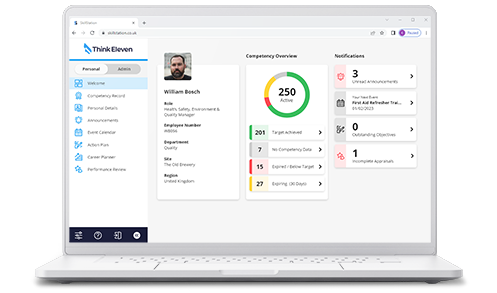As organisations embrace Artificial Intelligence (AI) in their learning and development efforts, it's crucial to understand both its potential and limitations. This article explores how AI offers opportunities for personalised learning and data-driven insights, while also highlighting the need for careful navigation to maximise its impact effectively.
In recent years, Artificial Intelligence (AI) has garnered immense popularity across various industries, with Learning and Development (L&D) being no exception. However, amidst this surge in popularity, it's evident that many learning, training and HR system providers have rushed to include some form of AI feature into their platforms with varying levels of success.
These new features usually take the form of a text generative AI model. Whilst this may be useful for smaller administrative tasks, this surface-level approach doesn’t leverage the potential of technology to provide something game-changing to the organisation. Instead, sceptically viewed, this could be seen as a sales gimmick, and to avoid the perception of falling behind the competition.
This blog aims to delve into the pervasive trend of AI in L&D, examining potential opportunities for harnessing AI in a meaningful way and exploring the limitations of AI in addressing the complex needs of organisations and employees.
The Growing Trend of AI in L&D
The pervasiveness of Artificial Intelligence in Learning and Development reflects a broader shift towards digital transformation within organisations. In recent years, AI has gained significant traction as a promising solution to help address the evolving needs of workplace training and skills. So far, the streamlining of administrative tasks with generative text models or optimised help system with chatbots are the most common place use, but the full potential of technology is left on the table.
This untapped potential has become the focal point in recent discussions surrounding the future of L&D, with many viewing it as a catalyst for driving innovation and organisational growth.
The Full Potential of AI in L&D
Harnessing AI presents a range of opportunities for driving meaningful and impactful outcomes.
One possible opportunity lies in the ability of AI to personalise learning experiences at scale. By leveraging data analytics and machine learning algorithms, AI can tailor learning content and delivery methods to individual employee needs, preferences, and learning styles. This not only could enhance engagement and motivation, but also accelerate skill acquisition and improve knowledge retention.
Another avenue of exploration could be the use of AI-driven analytics to offer valuable insights into employee learning behaviours, performance trends, and skill gaps. The easy access to these insights AI could provide, organisations can make better, data-driven decisions to optimise learning programs, allocate resources, and forecast future skills and training needs.
Ultimately, by strategically integrating AI into workforce learning and development initiatives, organisations can unlock new levels of efficiency, effectiveness, and innovation, empowering employees to thrive in an ever-evolving digital landscape.
The limitations of AI in Organisational L&D
Exploring the limitations of AI in organisational learning reveals challenges stemming from its oversimplification, and difficulty in adapting to dynamic environments.
For example, an important point to consider is that while AI can provide valuable insights into skills gaps and learning analytics based on internal data, its visibility is limited to the organisation's internal ecosystem. This means that AI may not have access to broader industry trends, emerging technologies, or evolving job requirements beyond what is contained within the organisation's data. As a result, there is a risk of an AI-driven analysis that overlooks external factors that could impact employees' skill development and the organisation's competitiveness in the broader marketplace.
Furthermore, AI's reliance on static data models may hinder its ability to adapt to the rapidly changing landscape of industries and job roles. While AI can analyse historical data to identify current skill gaps, it may struggle to anticipate future trends or identify emerging skills that are in demand. This highlights the importance of complementing AI-driven analyses with human expertise and external research to ensure a comprehensive understanding of the skills landscape and effective planning for future learning initiatives.
Ultimately, while AI can provide valuable insights and automation capabilities in skills gap analysis and learning analytics, organisations must recognise its limitations and supplement AI-driven approaches with human judgment and external research to ensure a holistic and forward-thinking approach to workforce learning and development.
Conclusion
As AI increasingly permeates L&D initiatives, it's evident that its integration often falls short of realising its full potential. While AI-driven features like chatbots and text generators streamline administrative tasks, they may not offer substantive improvements to organisational operation. However, amidst this trend, there are significant opportunities to leverage AI for personalised learning experiences and data-driven insights. By tailoring content to individual needs and utilising AI analytics, organisations can enhance efficiency and innovation in workforce L&D.
Nevertheless, it's crucial to recognise AI's limitations, such as its reliance on internal data and potential oversight of external factors. Thus, a balanced approach that combines AI-driven insights with human expertise is essential for maximising the impact of AI in workforce development and ensures a forward-thinking organisational strategy.


